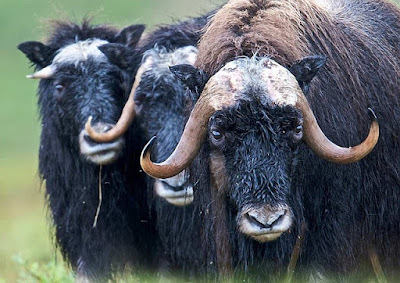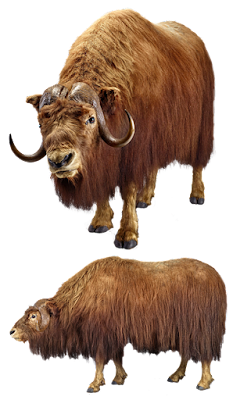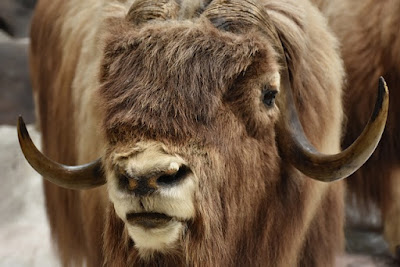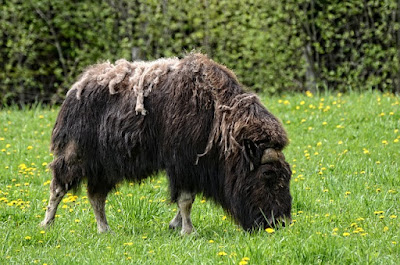The Mighty Muskox: Surviving the Arctic's Harshest Climate
In the cold Arctic tundra, a remarkable and tenacious creature roams the vast, snow-covered landscapes – the muskox. Often described as surviving relics of the last ice age, these magnificent mammals have adapted to some of the harshest conditions on Earth. Muskoxen are not only remarkable survivors but also key players in the Arctic's fragile ecosystem. In this article, we'll delve deeper into the world of muskoxen, exploring their unique characteristics, ecological importance, and conservation efforts aimed at ensuring their continued survival.
Majestic Muskoxen: A Glimpse into Their World
The muskox (Ovibos moschatus) is a large, shaggy herbivorous animal belonging to the family Bovidae, which also includes bison, buffalo, and domestic cattle. These animals are often recognized by their strong, barrel-shaped bodies covered with long, thick hair, which acts as insulation against the harsh Arctic cold. In fact, their thick woolly fur can keep them warm even in temperatures as low as -40°F (-40°C).
Muskoxen are found primarily in the Arctic regions of North America and Greenland, preferring to live in open tundra, river valleys, and coastal plains. Their diet consists mainly of vegetation including grasses, sedges and lichens. Despite their large size, these herbivores are excellent grazers and can efficiently extract nutrients from sparse Arctic vegetation.
Unique customization
Surviving in the Arctic requires more than just a warm coat. Muskoxen have several unique adaptations that enable them to thrive in these extreme conditions:
- Huddle Defense: The Muskoxen have a striking defense mechanism against predators, primarily wolves and bears. When threatened, they form a defensive circle, with their young and weaker members on the inside and the adults on the outside. This cooperative defense strategy, known as a "muscox huddle", makes it challenging for predators to break through their protective barrier.
- Incredible Fur: The muskoxen's thick, dense fur acts as a remarkable insulator, trapping warm air close to their body. This fur is so effective that it can even trap moisture and snow, creating an icy layer that further increases insulation.
- Adaptations of hoofs: Muskoxen have specialized hooves that are adapted for digging into snow to reach the vegetation below. Their sharp hooves can also break ice and reach water sources.
Ecological importance
Muskoxen play an important role in the Arctic ecosystem. As herbivores, they help regulate plant populations by grazing vegetation, which in turn affects the distribution and abundance of different plant species. This grazing behavior can have cascading effects on the entire ecosystem, affecting populations of other herbivores, predators, and even birds.
Additionally, muskoxen are important prey species for apex predators such as wolves and bears. They provide a source of food for these carnivores during the harsh Arctic winter when hunting other prey can be challenging. Therefore, their existence helps maintain the delicate balance of predator-prey relationships in the Arctic.
Conservation efforts
Despite their resilience and adaptability, muskoxen face many threats to their survival, including climate change, habitat degradation, and hunting. Climate change is of particular concern, as it could lead to habitat loss and disrupt the delicate balance of the Arctic ecosystem.
Conservation efforts are underway to protect these iconic creatures. These initiatives include habitat conservation, sustainable hunting practices, and research on the impacts of climate change on muskox populations. By understanding and addressing these challenges, we can hope to ensure the continued survival of these incredible animals.
Muskox are a symbol of resilience in one of the most hostile environments on Earth. With their remarkable adaptations and ecological importance, they are testament to the wonders of nature. As we strive to protect the Arctic and its unique inhabitants in the face of climate change, muskox serve as a powerful reminder of the need to preserve our planet's fragile ecosystems and the incredible biodiversity they support. .
Here are some interesting facts about Muskoxen:
- Ancient Species: Muskoxen are often referred to as surviving relics of the last ice age. Their ancestors roamed the Earth 12,000 years ago, making them one of the oldest large mammals still in existence.
- Distribution: Muskoxen are found primarily in the Arctic regions of North America and Greenland. Their range includes Alaska, Canada, and parts of Russia.
- Social Behavior: Muskoxen are highly social animals and live in herds, ranging in size from a few individuals to over 100. These herds are usually led by a dominant female known as the "lead cow".
- Distinctive Appearance: Their appearance is characterized by a thick layer of shaggy hair that can reach a length of up to 3 feet (0.9 m). These hairs act as protection from extreme cold and give them a distinctive, prehistoric appearance.
- Adaptive Fur: The muskox's woolly coat is incredibly effective at retaining heat. It consists of a thick outer layer and a soft, insulating underlayer called kivyuut. Kivyuut is one of the warmest natural fibers in the world, even warmer than sheep's wool.
- Size and weight: Adult muskoxen are large and heavy animals, with males (bulls) weighing between 600 to 900 pounds (270 to 410 kg) and standing about 4.5 to 5.6 feet (1.4 to 1.7 m) tall at the shoulder. .
- Survival Skills: Muskoxen are known for their hard survival in harsh conditions. They can tolerate temperatures as low as -40°F (-40°C) and are well adapted to digging in the snow to find food during winter.
- Vocalization: While generally silent, the muskoxen can make a variety of sounds, including grunts, snorts, and bellows. These vocalizations are used for communication within the herd.
- Horned in both sexes: Both males and females have distinctively curved horns. In males, the horns can be quite large and are used in battles for dominance during the breeding season.
- Conservation Status: Muskox populations have faced challenges due to historical overhunting, habitat loss, and climate change impacts. However, they are now protected by conservation efforts, and their population has been recovering in recent years.
- Predator Defense: Muskoxen are known for their unique defensive behavior, where they form a defensive circle when threatened by predators. This protective structure, known as a "muscox huddle", helps fend off predators such as wolves and bears.
- Diet: These herbivores feed mainly on grasses, sedges, lichens and other vegetation. During the summer, they graze on a variety of plant species, while in the winter, they rely more on lichens and mosses.
- Reproduction: Muskoxen have a slow reproduction rate. Females usually give birth to one calf after a gestation period of about 8.5 months. Calves are born in the spring and are highly vulnerable to predation during their early months.




Comments
Post a Comment